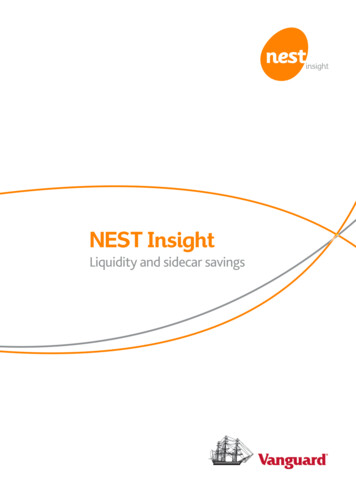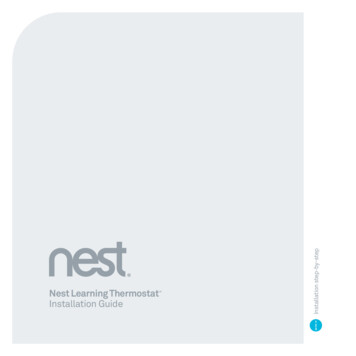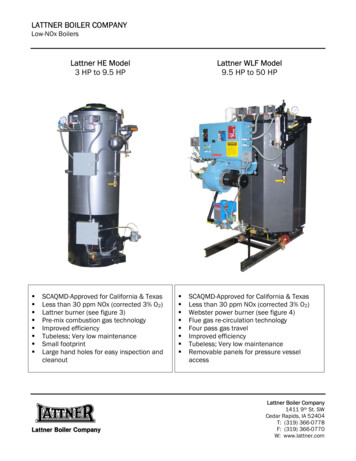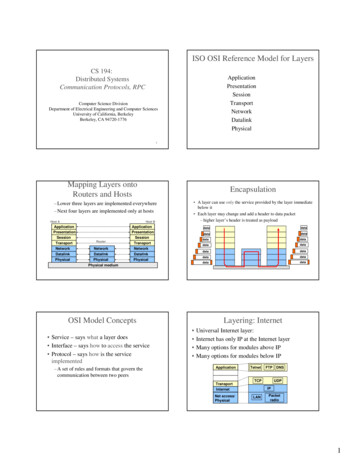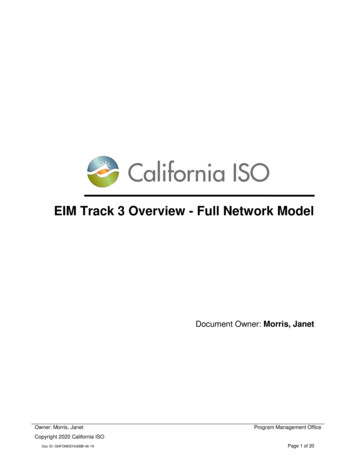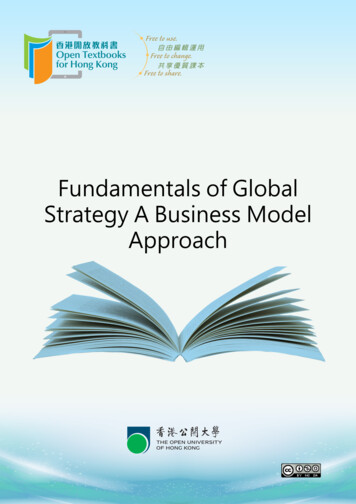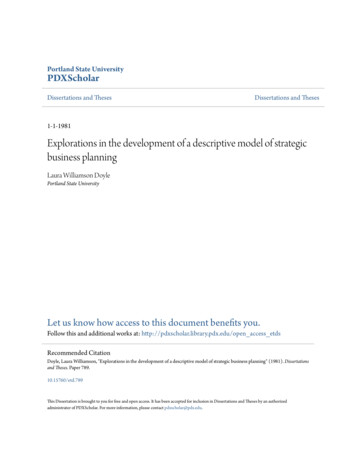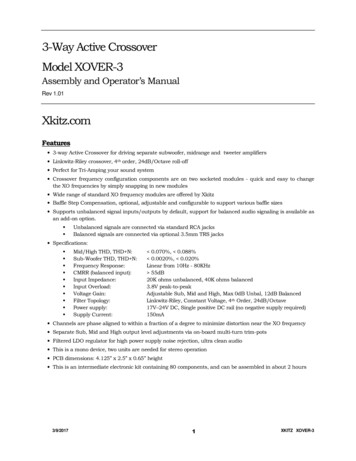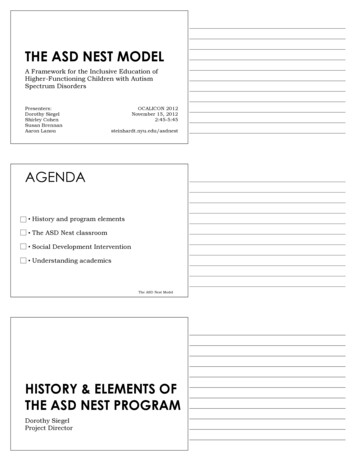
Transcription
THE ASD NEST MODELA Framework for the Inclusive Education ofHigher-Functioning Children with AutismSpectrum DisordersPresenters:Dorothy SiegelShirley CohenSusan BrennanAaron LanouOCALICON 2012November 15, 20122:45-5:45steinhardt.nyu.edu/asdnestAGENDA History and program elements The ASD Nest classroom Social Development Intervention Understanding academicsThe ASD Nest ModelHISTORY & ELEMENTS OFTHE ASD NEST PROGRAMDorothy SiegelProject Director
THE BASICS Begun in 2003 in PS 32 in Brooklyn, NY In 2012-13, serves close to 650 higher functioningchildren with autism and more than 2,000children in general education 157 inclusive Nest classrooms from Kindergartenthrough 10th grade 27 schools in every borough of New York CityThe ASD Nest ModelNumber of Nest Classes per Gradein NYC Public Schools, 2012-2013302520151050K1238 9 104 5 6 7Grade LevelThe ASD Nest ModelOUR GOAL To create a therapeutic educational model that is: both inclusive and challenging a vehicle for therapeutic change based on evidenced-based and promising practices responsive to the unique combination of strengthsand deficits these students possess able to be implemented by diverse schools anddistrictsThe ASD Nest Model
SOME ELEMENTS OF A PROGRAM TOSUPPORT STUDENTS WITH AUTISM therapeutic services/supportsto address challenges educational setting consistingof a small inclusiveclassroom with adequatesupports consistent therapeutic andinstructional approach fromone setting to another, oneservice to another, and oneyear to the next training and on-site supportfor both therapists andteachers professional collaborationopportunities support for children’s socialinteractions with typicallydeveloping peers school and district support home-school collaborationThe ASD Nest ModelTHE ASD NEST PROGRAM &THE RUBBER BAND BALLeach rubber band corresponds to a differentelement of the ASD Nest Program each program element is necessary in creating theball AND, all elements must be present and workingtogether synergistically for “bounce” to occur The ASD Nest ModelA PROGRAM WITH BOUNCE Nest classroom: Small, collaboratively taught class with two teachers (noaides) Nest programs start with two kindergarten classes thatage up each year Class ratios: Kindergarten: 12 students, 4 with ASD 1st-3rd: 16 students, 4 with ASD 4th & 5th: up to 20 students, up to 5 with ASDAcademic curriculum identical to that used in theschool’s general ed classroomsThe ASD Nest Model
A PROGRAM WITH BOUNCE Nest classroom (cont.): Clear expectations of what classrooms should looklike and the strategies to be used Pull-outs & disruptions kept to a minimum Home/school connection: phase-in strategy with home and school visits a home/school communication notebook monthly parent meetings / workshops led by a socialworker or guidance counselor collaborative planningThe ASD Nest ModelA PROGRAM WITH BOUNCE Nest staff: Skilled, smart, teachers who are eager to learn Highly skilled, collaborative therapists (speechpathologists, occupational therapists and socialworkers) All teachers and therapists receive graduate leveltraining on autism, behavior, Nest strategies andsocial development Principals receive training and on-site supportduring the planning year and the first three yearsof the programThe ASD Nest ModelA PROGRAM WITH BOUNCE Nest staff (cont.): Weekly 90-minute team meetings are mandated forall staff; each student’s progress is assessed andspecific strategies are agreed upon Therapists and teachers work as a collaborative,interdisciplinary team All teachers and therapists receive a variety ofprofessional development activitiesThe ASD Nest Model
A PROGRAM WITH BOUNCE Nest school: Host schools are typical neighborhood schools withflexible, collaborative principals, instructionallysound practices and a positive approach tobehavior Principals are experienced at running their schooland are good instructional leaders School has space to accommodate the need for oneadditional classroom per yearThe ASD Nest ModelA PROGRAM WITH BOUNCE Nest district: Understanding and commitment from all levels ofthe school district, especially the top Adequate, timely funding: The ASD Nest Programcosts the same or less than other public or privateprograms for children with autism Collaboration with university-based autism expertsfor training, professional development and on-sitesupport for teachers and therapists Student evaluation process identifies and placesonly appropriate children in the programThe ASD Nest ModelTHE ASD NESTCLASSROOMShirley Cohen, Professor EmeritusHunter College, City University of New York
THE TEACHERSWHO ARE THEY ?(And how did they get to be fabulous?) Selection Pre-service training Professional developmentThe ASD Nest ModelSUMMER INSTITUTECOURSES Autism Spectrum Disorders: Characteristics,Assessment, Implications for Intervention, andEducational Strategies Behavioral Theory and Its Applications to YoungChildren with Special Needs (with a focus onAutism Spectrum Disorders)The ASD Nest ModelTHE ENVIRONMENTWhat does the room look like at thebeginning of the school year in akindergarten class.and why?The ASD Nest Model
A WHOLE CLASSINSTRUCTION AREAThe ASD Nest ModelA BREAKAREAThe ASD Nest ModelA FIRSTGRADE“OFFICE”The ASD Nest Model
OTHER STRATEGIES ANDPRACTICES Classroom Guideposts Three-Tier Model of Supports for theASD NestThe ASD Nest ModelCLASSROOMGUIDEPOSTS Prevention strategies Instructional strategies and supports Social supports Teaching replacement behavior Positive reinforcement systemsThe ASD Nest ModelPREVENTIONSTRATEGIESDesigned to keep interfering behavior fromoccurring or to minimize its disruptive effect uponthe child with ASD and his classmatesExamples: Environmental modifications to address sensoryissues Visual aids Priming Frequent opportunities for making choicesThe ASD Nest Model
VISUAL AIDSThe ASD Nest program uses lots of visual aidsWhy?Because many students with ASD are better atvisual processing than auditory processing, andbecause visual aids can be very valuable inhelping students who have organizational issues,which are common in students with ASD.The ASD Nest ModelTHE INCREDIBLE5-POINT SCALEThe ASD Nest ModelMORNING SCHEDULEThe ASD Nest Model
INSTRUCTIONALSUPPORTS Use co-teaching models that supportdifferentiated instruction Probe to ensure that a student understands thesteps required in a task before being expected tocomplete it independently Simplify tasks by shortening them or breakingthem into parts Create checklists for student use in completingcomplex academic tasksThe ASD Nest ModelSOCIAL SUPPORTS Experience sharing Social problem solving Use of Social Stories Role playThe ASD Nest ModelTEACHINGREPLACEMENT BEHAVIOR Help cards The “break” programI NEED ABREAK!HELP!The ASD Nest Model
POSITIVE REINFORCEMENTSYSTEMS “Catch them being good” Class-wide “point” (or checkmark, or sticker, or smileyface or ticket or cotton ball)system Individual (positive)behavior chartsThe ASD Nest ModelTHE ASD NEST THREETIER SYSTEMWHAT IS IT? A structure for use of the Classroom Guidepostswith a focus on issues in four (overlapping)areas: sensory, academic, behavioral, and socialThe ASD Nest ModelTIER IStrategies for use in all ASD Nest classroomsExamples Behavioral: Tell students what to do rather thanwhat not to do Social: Lead whole class/small groups in roleplaying new/difficult situations Academic: Task analyze complex academicactivities to clarify component steps andsequencesThe ASD Nest Model
MOVEMENT TO TIER II Requires completion of Tier I Checklist and teammeeting to plan more effective use of Tier Istrategies Is followed up in two to three weeks to evaluateprogress Student is moved to Tier II if the team concludesthat additional, individualized plannedinterventions are neededThe ASD Nest ModelTIER IIIndividualized, planned interventionsExamples Sensory/motor: Use individual sensory tools asrecommended by OT, e.g., pencil grips, slantboards, weighted vests Behavioral: Use individualized behaviorreinforcement system Academic: Provide one-to-one and small grouppreviewing for new/challenging content Social: Create Social Story books written forand with individual studentThe ASD Nest ModelMOVEMENT TO TIER III Requires Completion of Academic Screening Formif Tier III is needed for academic supports Requires implementation of a functional behaviorassessment (FBA), including parent interview, ifTier III is need for behavioral supportsThe ASD Nest Model
TIER IIIExamples Academic: Modify content, work expectations,and instructional pacing, and provide 1:1support during lessons and activities/tasks Behavioral: Provide frequently scheduledteacher-supported break times throughout theday, and implement a more intensivereinforcement system with frequent teachermonitoringThe ASD Nest ModelENSURING FIDELITY OFIMPLEMENTATIONThe Tier I Classroom Checklist ofStrategies and SupportsThe ASD Nest ModelRELATING TO FAMILIESThe ASD Nest Model
AND DON’T FORGETABOUT HAVING FUNThe ASD Nest ModelSOCIAL DEVELOPMENTINTERVENTIONSusan Brennan, CCC SLPPrimary Developer of SDISOCIAL DEVELOPMENTINTERVENTIONSDI is a social therapeutic intervention implemented in tandemwith academics. It is based on the developmental language model,relationship-development and social cognitive theories, and isused to cultivate the social and pragmatic language skills ofchildren with ASDs.The ASD Nest Model
BUT HOW WILL THESOCIAL GENERALIZE?Well, let’s makeSpeech andLanguage Therapy aintegral part of theNest!Ohhh. and theteachers willcollaborate withthe SLP and thestudents duringthis ‘lab-time!Yeah, Nest kids willhave a Pragmaticbased ‘lab-time’ 3 to5 times a week!That’s it! Thelanguage, concepts,and strategies willthen be integratedinto the classroom!The ASD Nest ModelSCHOOL IS SOCIAL!!!!The ASD Nest ModelCOGNITIVE THEORIESCentral CoherenceTheory of MindExecutive IALPRAGMATICSThe ASD Nest Model
Social sDevelopmentThe ASD Nest ModelSDI%Team%Planning%MapUnit% :%! !unit!blurb! LanguageProblem'SolvingPragmatic LanguageProblem Solving experience sharing experience sharing ocabulary,!Activities!&!Explorations experience sharing experience sharing Social Relational &Social l!Lunch!&!Recess 2012 Brennan, Lanou, HoughThe ASD Nest ModelGOAL #1SOCIAL RELATIONAL DEVELOPMENT& SOCIAL COGNITIONAn intervention that encourages engagement,shared imagination, and dynamic interactions. Itfocuses on social communication and connectedthinking to support classroom learning.The ASD Nest Model
GOAL #2PRAGMATIC LANGUAGE &CONVERSATIONBuilding attention to and the expression of anauthentic use of language in a social context byexchanging thoughts, opinions and feelings(verbally & non-verbally)The ASD Nest ModelGOAL #3PROBLEM SOLVINGThe ability to appraise a situation, consider relevantexperiences, new information that is given, theinformation that is not known, and then put it alltogether to make a guess about the best solutionThe ASD Nest ModelASD NEST PROGRAMSDI GUIDEPOSTSELEMENTARY SCHOOL MODELSDI Guideposts for Social Development Across the School DayHm, her eand fac yes etelling are misn’t in e she tein mea rested l worms6This is a list of social development focus areas for the students in the ASD Nest Program. Strategies outlined here aredesigned to be incorporated in the classroom, the therapy rooms, into instructional lunch and when possible into clustertimes. By understanding and addressing these social deficits, we are supporting our students’ full participation in theirschool environment. These strategies serve to reduce interfering behaviors, giving each child greater access to thecurriculum. When targeting social deficits, we also are consistent in providing positive behavioral supports.SectionsThe BasicsPage 1ExperienceSharingLanguage FlexibilityIncorporatingStrengths &InterestsPage 2Page 2Page 3Page 3Page 4Page 4SDI Basics lloGeneral structure,staff configuration, SDI in caseHeconferencesisHellomy nameHellomy name ismy name isStudents and adults siter in a circle on the floorPlayers: SLP and classroom teachers, OT whenraphtogetherogdevipossibleor around a table. Remember we are modeling anddirector set designerLed by the SLP and planned in collaboration withencouraging social interaction so set up should be asrelevant staffnaturalistic as possible.Assigningrolesfor group activitiessupportsproblemThere should be at least one lessadult thanchildrenshouldbe atsolvingevery case conference. Social GPSsactively involved in focus time and no more thanI’m thinking three adults. Other adults should rotate: note taking,about the group video taping, special support Note taking includes observations and dataso I’m going to collection. For example: each student’s goals shouldbe at the top of the notes. The focus can be on a singlesit on the rug.4 child to monitor and record progress across goals, ORone goal area can be considered in relation to all ‘4’students. Who and how should be determined atplanning sessions and observations should be used incase conferences and for planning.Feedback and Reflection should frame each session.Hand-raising in social development time is notnecessary and unnatural.* Carol Gray; † Elisa Gagnon development should be discussed for every child that11:30is conferenced.SDI Units should be read and discussed as a team.Incorporation of unit concepts should be consideredat all planning sessions.12:15 Surprise!The Team Planning Map is a tool for planning at thestart of each unit. All team members use this tool toIncorporatinginto the classroom scheduleincorporate unit concepts into relevanttimes offlexibilitytheday.Social Stories *, Comic Stripping*, Role-play andPower Cards† all support social development andThe ASDshould be incorporated into focus time.Sensory diets should be understood by all staff andincorporated into focus time. 2008 Brennan, Hough & MurrayNest Modelp. 1
SDI SESSIONS:BALANCING EXPERIENCE SHARING& SOCIAL COGNITIONKindergarten to 2nd grade3rd to 5th gradePutting the social world onthe radar Explore & Engage! Model Highlight Social Language Expose toSocial ConceptsThinking throughsocial world Explore & Engage! Roleplay Social Relevance Put the Social in Context Investigate SocialConceptsThe ASD Nest ModelTailoring an intervention for a public ICT ASD program cial StoriesSocial ComicStripsMyles,Trautman,SchelvanThe HiddenCurriculumBloom & LaheyBloom & TinkerDevelopmentSocialPragmaticModelSelfAdvocates .VermeulenContextBlindnessThe ASD Nest ModelJessieSapersteinAriNe’emanZosia ZaksStevenShoreJohn ScottHolmanNest StudentsThe ASD Nest Model
WEAVING AND LAYERINGSOCIAL CONCEPTSINTO THE SCHOOL DAYThe ASD Nest ModelUNDERSTANDINGACADEMICSAaron LanouDirector of Professional DevelopmentOVERVIEW Academic Strengths Theoretical Frameworks for AcademicChallenges Academic Difficulties StrategiesThe ASD Nest Model
ltficdifmsbleproryetmStrategiesTHEORY OF MINDUnderlyingCausesCENTRAL COHERENCEEXECUTIVE FUNCTIONINGLanou/Hough 2009The ASD Nest ModelACADEMIC STRENGTHS READING WRITING MATH Word reading(hyperlexia) Creativity Computation NonfictionGrammar &syntax Recall of basicfacts Recallingdetails Writing ontopics ofinterest FollowingalgorithmicproceduresThe ASD Nest ModelTHEORETICALFRAMEWORKS Theory Centralof MindCoherence Theory ExecutiveFunctioningThe ASD Nest Model
THEORY OF MIND Theability to recognize and interpret otherpeople’s thoughts, feelings, beliefs andintentions, live and in the moment, and tounderstand the implications for one’sbehaviorShe has to “compute” other’sintentions and states of mind, to tryto make algorithmic, explicit what forthe rest of us is second nature.O. Sacks, 1995 p. 270The ASD Nest ModelCENTRAL COHERENCETHEORY Difficulty conceptualizing the “big picture” or“gist” Hyper-focus on details at the expense of thelarger contextCan’t see the forest for the trees?!I can’t see the forest for the veinson the leaves.The ASD Nest ModelEXECUTIVEFUNCTIONING Organizing and coordinating multiple cognitivetasks, such as: recalling & applying information from memories attention & self-monitoring flexibility in problem solving time management & prioritizing abstract thinkingCompany CEOWithout appropriate support, the childwith Asperger’s Syndrome may feel he isdrowning in a million different sub-tasks.S. Shore in Attwood, 2007The ASD Nest Model
READING CHALLENGES1. Tracking a story / synthesizing text2. Thinking about characters3. Understanding figurative & higher-orderlanguageThe ASD Nest ModelTHINKING ABOUTCHARACTERS Understanding Considering Inferring Makingcharacter thoughts & feelingscharacter motivation & intentioninternal character traitsself-to-text connections Drawinginferences independentlyThe ASD Nest ModelNonsense wordPickle Puss by PatriciaReilly Giff, pp. 4-7Non-literallanguagePerspectivetaking“Emily looked down at the book. It had about askillion pages. It would take forever to read.“Well ” she said. “Go ahead. Try it,” said Freddie.“I guess so,” Emily said. She went to Mrs. Baker’sdesk. Too bad she didn’t have a skinnier book. SheDeception looked back. Freddie was talking to his friendEdward. Emily stuck the fat book on the book cart.She grabbed another one. It was much skinnier.She gave it to Mrs Baker. Mrs. Baker checked it out.“You like snakes?” she asked. “Yucks,” said Emily.Then she looked at the book. There was a snake onthe cover. It was the kind with the fat neck. Its toothwas sticking out. “I mean, I love them,” Emily said.”Perspective-taking & lyingIrrelevant detailInferenceThe ASD Nest Model
WRITING CHALLENGES1. Concept of writing2. Organizing and prioritizing3. Considering characters and audienceThe ASD Nest ModelORGANIZING &PRIORITIZING Planningand organizing structure Understanding Managingdetails and the main ideatime and self-monitoring Completinglong-term projectsThe ASD Nest ModelMATH CHALLENGES1. Abstract concepts2. Abstract skills3. Word problems4. Explaining thinkingThe ASD Nest Model
EXPLAINING THINKING Checking Tryingwork for accuracyalternate strategies Explainingreasoning with wordsThe ASD Nest ModelACADEMIC STRATEGIESInstructionalprinciples: VisualsBenefits: Use visual strength Organizeinformation Graphic organizers Social-cognitivestrategies Concretize abstractconcepts Incorporatingstudent interests Increase motivationThe ASD Nest ModelThink about yourcharacterThink about howyour life relates to thetextThe ASD Nest Model
What thetext says Your thinkingINFERENCEgraphic representation of“making an inference”The ASD Nest oblem)fixed)revised story mountainThe ASD Nest ModelNovember 2012Sunday1Monday2Tuesday3Wednesday ns dueGathering8910*topic due1516*draft due17222324*editing TINGDUEcolor-coded calendarThe ASD Nest Model
Explaining your work in wordsI knew ,the numbers the problem saysand I needed to know ,what you’re looking forso I andwhat operation or strategy you usedfound .your answerLanou 2010explaining your thinking workon the state math testTuesday, June 8, 2010The ASD Nest ModelCOMIC STRIP CONVERSATIONSCarol GrayThe ASD Nest ModelREFERENCESAttwood, T. (2007) The Complete Guide to Asperger Syndrome. Jessic
ASD NEST PROGRAM SDI GUIDEPOSTS This is a list of social development focus areas for the students in the ASD Nest Program. Strategies outlined here are designed to be incorporated in the classroom, the therapy rooms, into
